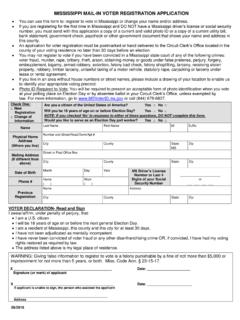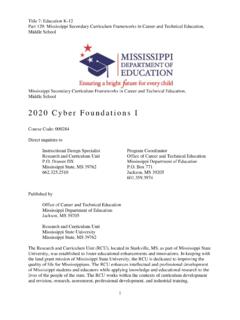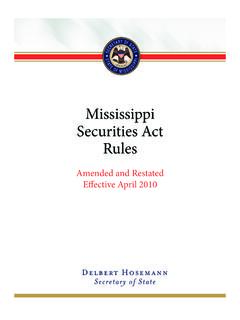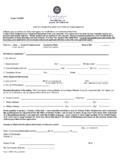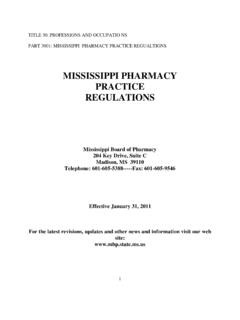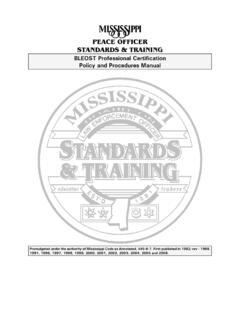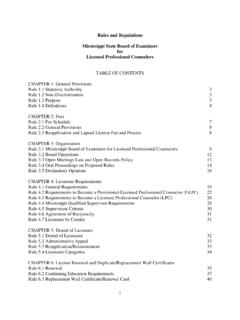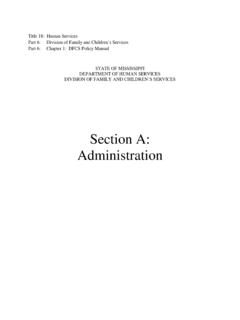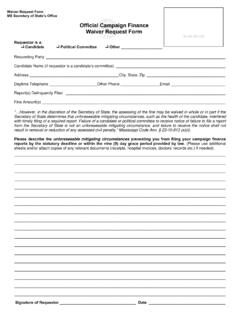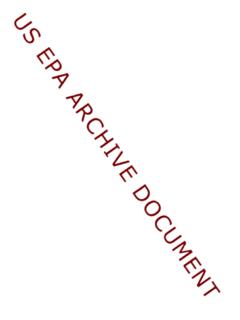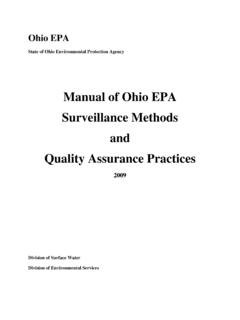Transcription of Title 11: Mississippi Department of Environmental Quality ...
1 1 11 Miss. Admin. Code, Pt. 2, Ch. 1, Proposed Amendments, August 16, 2016 Clean followed by Variance Title 11: Mississippi Department of Environmental Quality Part 2: Air Regulations Part 2, Chapter 1: Mississippi Commission on Environmental Quality , Air Emission Regulations for the Prevention, Abatement, and Control of Air Contaminants (Adopted May 8, 1970. Amended: January 25, 1972; May 26, 1976; January 31, 1978; April 25, 1978; March 12, 1981; August 26, 1981; December 8, 1982; May 9, 1984; September 17, 1984; July 17, 1985; March 12, 1986; June 25, 1986; September 23, 1987; March 23, 1988; April 25, 1988; December 14, 1988; August 23, 1989; April 25, 1991; January 23, 1992; December 9, 1993; August 25, 1994; May 25, 1995; January 25, 1996; August 22, 1996; April 24, 1997; January 22, 1998; October 22, 1998; April 22, 1999; February 24, 2000; August 22, 2002; November 20, 2003; January 26, 2006; November 16, 2006; December 11, 2008; October 28, 2010; December 14, 2011; October 24, 2013; November 20, 2014.)
2 And Last Amended Date of Adoption of Amendments) TABLE OF CONTENTS Rule General .. Page 3 Rule Definitions .. Page 4 Rule Specific Criteria for Sources of Particulate Matter .. Page 7 A. Page 8 B. Equivalent Opacity .. Page 8 C. General Nuisances .. Page 8 D. Fuel Burning .. Page 8 E. Kraft Process Recovery Boilers .. Page 9 F. Manufacturing Processes .. Page 9 G. Open Burning .. Page 10 H. Incineration .. Page 11 I. Sampling Ports .. Page 12 J. More Restrictive Emission Limits .. Page 12 Rule Specific Criteria for Sources of Sulfur Compounds .. Page 12 A. Sulfur Dioxide Emissions from Fuel Burning .. Page 13 B. Sulfur Dioxide Emissions from Processes .. Page 13 Rule Specific Criteria for Sources of Chemical Emissions.
3 Page 17 A. Page 17 2 11 Miss. Admin. Code, Pt. 2, Ch. 1, Proposed Amendments, August 16, 2016 Clean followed by Variance B. Miscellaneous Chemical Emissions .. Page 17 Rule New Sources .. Page 18 A. Kraft Pulping Mills .. Page 18 B. Other Limitations .. Page 18 C. New Source Performance Standards .. Page 18 D. Additional Requirements for Infectious Waste Incineration .. Page 18 Rule Page 19 Rule Provisions for Hazardous Air Pollutants .. Page 19 A. Hazardous Air Pollutant Emission Standards .. Page 19 B. National Emission Standards for Hazardous Air Pollutants; Compliance Extensions for Early Reductions .. Page 20 C. Case by Case Maximum Achievable Control Technology Requirements .. Page 20 Rule Stack Height Considerations.
4 Page 20 A. Definitions .. Page 20 B. Stack Height Effect on Emission Limitations .. Page 24 Rule Provisions for Upsets, Startups, Shutdowns, and Unplanned Maintenance .. Page 25 A. Upsets .. Page 25 B. Startups and Shutdowns .. Page 25 C. Unplanned Maintenance .. Page 26 Rule Severability .. Page 27 Rule Provisions for Existing Hospital/Medical/Infectious Waste Incinerators .. Page 27 A. Page 27 B. Definitions .. Page 28 C. Emission Page 36 D. Operator Training and Qualification Requirements .. Page 39 E. Waste Management Guidelines .. Page 42 F. Inspection Guidelines .. Page 43 G. Compliance and Performance Testing .. Page 44 H. Monitoring .. Page 52 I. Reporting and Recordkeeping Requirements.
5 Page 55 3 11 Miss. Admin. Code, Pt. 2, Ch. 1, Proposed Amendments, August 16, 2016 Clean followed by Variance J. Compliance Schedules .. Page 58 Rule Provisions for Existing Commercial and Industrial Solid Waste Incineration Units .. Page 61 A. Emission Standards .. Page 61 B. Applicability .. Page 61 C. Schedule for Compliance .. Page 65 D. Permitting Page 66 E. Clarifications of Terminology .. Page 66 Rule General. A. Authority. Pursuant to the authority granted by Miss. Code Ann. 49-17-17, the following regulations are adopted for the purpose of preventing, abating, and controlling air pollution caused by air contaminants being discharged into the atmosphere as particulates, smoke, fly ash, solvents, and other chemicals or combinations thereof.
6 B. Except as otherwise noted herein, stack emissions testing for demonstration of compliance with the regulations herein may be performed in accordance with the Test Methods of the U. S. Environmental protection agency in place at the time testing is performed or as otherwise approved by the staff of the Mississippi Office of Pollution Control and the U. S. Environmental protection agency . (1) Notwithstanding this or any other provision in these or any other regulations, the owner or operator may use any credible evidence or information relevant to whether a source would have been in compliance with applicable requirements if the appropriate performance or compliance test had been performed, for the purpose of submitting compliance certifications.
7 (2) Notwithstanding any other provision in these or any other air pollution control regulations, any credible evidence or information relevant to whether a source would have been in compliance with applicable requirements if the appropriate performance or compliance test had been performed, can be used to establish whether or not a person has violated or is in violation of any standard or applicable requirement. C. In the event of a conflict between any of the requirements of these regulations and/or applicable requirements of any other regulation or law, the more stringent requirements shall be applied. Source: Miss. Code Ann. 49-2-9(1)(b), 49-17-17, 49-2-1, et seq.
8 And 49-17-1, et seq. 4 11 Miss. Admin. Code, Pt. 2, Ch. 1, Proposed Amendments, August 16, 2016 Clean followed by Variance Rule Definitions. The terms used in the regulations shall, unless the context otherwise requires, have the following meanings: A. Air cleaning device. Any method, process or equipment which removes, reduces or renders less noxious air contaminants discharged into the atmosphere. This term is synonymous with air pollution control device. B. Air contaminant. Particulate matter, dust, fumes, gas, mist, smoke, or vapor, or any combination thereof produced by processes other than natural. C. Air contamination. The presence in the outdoor ambient air of one or more air contaminants which contribute to a condition of air pollution.
9 D. Air contamination source. Any source at, from, or by reason of which there is emitted into the ambient air any air contaminant, regardless of who the person may be who owns or operates the building, premises, or other property in, at, or on which such source is located, or the facility, equipment or other property by which the emission is caused or from which the emission comes. E. Air contaminant point source. Any single point of emissions of any air contaminant such as from an individual machine or combustion device. F. Air pollution. The presence in the outdoor ambient air of one or more air contaminants in quantities, of characteristic, and of a duration which are materially injurious or can be reasonably expected to become materially injurious to human, plant, or animal life or to property, or which unreasonably interfere with enjoyment of life or use of property throughout the State or throughout such area of the State as shall be affected thereby.
10 G. Air Quality Action Day. A day(s) the Executive Director determines that the air Quality data within a specifically named area within the state may reach levels at or above the national ambient air Quality standard for a specific pollutant. H. Ambient air. The encompassing atmosphere existing in the matter of space and to which life of this earth is adapted. For the purposes of these regulations, that portion of the atmosphere outside of buildings, stacks, and ducts. I. Atmosphere. The air that envelopes or surrounds the earth. This term is synonymous with ambient air. J. Commission. The Mississippi Commission on Environmental Quality . K. Excess (or excessive) emission.
